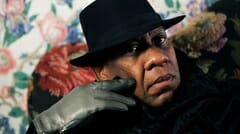The Gospel According to André

Oh, to spend a day with legendary, luminously sincere fashion editor André Leon Talley. For most of us poor unfortunates, that day will never come. For Kate Novack, that day came in 2016, lasted the entire year, and provided the structure of her new film, The Gospel According to André, a portrait of Talley and his irresistible grandeur. Partway through, an acquaintance describes him as “a towering pine tree of a guy,” which doesn’t quite do justice to his folkloric image. He’s a jovial giant warehoused in kaftans, wise enough that he knows things other people will never know, affable enough that he never holds his wisdom over you.
The Gospel According to André is very much about Talley’s experiences, being his life, times and philosophies, and less about his experience, being his accomplishments as a journalist and fashion icon. Novack never shies away from opportunities to bask in his warm presence and the obvious joy he takes in his profession. He’s a man full of stories. At 68 years old, he’s practically made of them. In the film, his vitality has a way of raising the dead. Novack uses archival footage of Talley’s mentor, Diana Vreeland, editor in chief of Vogue from 1963 to 1971, in tracing the arc of his career, but it’s his words that best capture her spirit. Talley paints her as a tasteful, no-nonsense woman with a flair for theatrics; she was petite, but stood so straight that she appeared seven feet tall.
Little wonder Talley grew close to her. He isn’t seven feet tall, but at 6’6” he’s close enough, and his penchant for drama may, almost 30 years after Vreeland’s death, surpass hers. The Gospel According to André zeroes in at first on his day to day and how he perceives fashion, which he clarifies is not what he lives for. “I live for beauty and style,” he says in the film’s opening line. “Fashion is fleeting. Style remains. I think that beauty comes in many forms. It could be a flower. It could be a gesture. It could be so many things, so many things.” He then quotes Voltaire’s Candide with the casual air of a person narrating newspaper headlines over coffee.
If you’re watching The Gospel According to André, you’re probably watching for the very things Talley pegs as transitory. Fashion is not one of the movie’s key components, but its dessert; the story of how Talley became—and is still becoming—Talley is the entree. We see clips of fashion shows and private moments between Talley and his friends—most notably journalist Tamron Hall, whom he fits for the final Obama state dinner in October of 2016, less than a month before the general election. She walks out in a gown looking like, as she proclaims, a princess, affirming the Talley approach to living. She is stylish. She is beautiful. She is glowing, within and without.
-

-

-

-

-

-

-

-

-

-

-

-

-

-

-

-

-

-

-

-

-

-

-

-

-

-

-

-

-

-

-

-

-

-

-

-

-

-

-

-








































